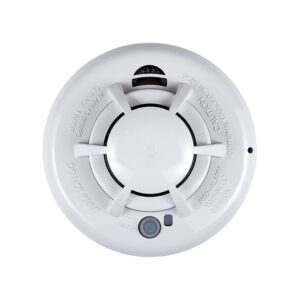Smoke and Fire Alarm /detectors will save lives and must be tested on a frequent basis to ensure proper operation if the need ever arises during an emergency. By law requires residential homes to have smoke detectors installed and the fire department can show up and inspect at any time.
Today we will be touching on monitored smoke detectors that are attached to a home security system, in the event of an alarm the fire department will be dispatched. This is great in the circumstances where people or animals are trapped in their homes from the fire and unable to call the emergency services.
The IQ Smoke is connected to your IQ Panel and monitored 24-7, whether your system is armed or not. The IQ Smoke detects the presence of smoke using photoelectric
smoke-sensing technology and conforms to UL 217. The IQ Smoke detects the presence of smoke particles as well as the rapid rise in heat that can come from a fire, even if there is no smoke. Because your system is always connected, you can receive a text or email alert if there are any problems, wherever you are.

Specifications:
- Power Source: 3 AAA PC2400 Duracell Procell batteries (1.5V 1100mAh) or 3 AAA Energizer E92 batteries (1.5V 1100mAh) (included)
- Audible Signal (ANSI Temporal 3): 85dBA min. in alarm
- Sensitivity: 1.5 – 5%/foot
- Supplementary Heat Rating: 135°F
- Operating Temperature: 40°F – 100°F (4.4°C – 8°C)
- Relative Humidity: 15 – 90% Non-Condensing
- Dimensions: Diameter 5″ x 5″D
- Regulatory Listing: UL 217
Features:
- Power Source: 3 AAA PC2400 Duracell Procell batteries (1.5V 1100mAh) or 3 AAA Energizer E92 batteries (1.5V 1100mAh) (included)
- Audible Signal (ANSI Temporal 3): 85dBA min. in alarm
- Sensitivity: 1.5 – 3.5%/foot
- Supplementary Heat Rating: 135°F
- Operating Temperature: 40°F – 100°F (4.4°C – 37.8°C)
- Relative Humidity: 15 – -90% Non-Condensing
- Dimensions: Diameter 5″ x 2.5″D
Detector Dirty Feature: When the detector has been contaminated, the yellow LED blinks once every 8 seconds and there is a chirp every 48 seconds. After 12 hours the panel will display a loss of supervision message.
Low Battery Detection: The Wireless Smoke Heat Alarm is powered by 3 AAA Duracell Procell or 3 AAA Energizer E92 batteries (included). The detector regularly checks for a low battery. If a low battery is detected, the transmitter sends a low battery message to the control panel, which displays the detector’s ID at low battery.
In addition, the yellow LED of the detector will blink every 12 seconds. The detector’s sounder will chirp every 48 seconds (yellow LED continues to blink) until the batteries are replaced. Pressing the hush button will silence the chirps for 12 hours, if no other trouble conditions exist. The batteries should be replaced WHEN the chirps begin. Be sure to replace the batteries with fresh ones.
Very important: Always call your alarm system provider and have your account placed on test prior to touching your smoke detector. Any movement can cause the detector to go off and send a signal which may trigger the fire department to come to your home immediately. False alarms are very serious and should be reduced at all costs.
How To Change Batteries In Your IQ Smoke & Heat Detector:
- Remove the detector from its mounting base by twisting the detector counterclockwise. Remove and dispose of the batteries according to your local
- To ensure proper power-down sequence, wait a minimum of 20 seconds before installing new
- Install 3 new AAA batteries (available from your local Duracell or Energizer dealer) in the battery Follow the polarity diagram inside the compartment. If the batteries are incorrectly inserted please remove gently with a non-conductive tool and correctly reinsert.
- Reinstall the detector onto the mounting base by turning the detector clockwise until the mating marks
- After the power-up sequence the green LED should blink about once every 12 seconds to indicate normal If the batteries are not installed correctly, the detector will not operate and the batteries may be damaged. If the detector does not power-up, check for correct batteries installation and for fully charged batteries.
- Test the detector (as described later).
CONSTANT EXPOSURES TO HIGH OR LOW TEMPERATURES OR HIGH HUMIDITY MAY REDUCE BATTERY LIFE.
Recommended Locations for Smoke Heat Alarm:
According to the National Fire Protection Association (NFPA) the major threat from fire in a dwelling unit occurs at night when everyone is asleep. The principal threat to
persons in sleeping areas comes from fires in the remainder of the unit; therefore, a smoke detector(s) is best located between the bedroom areas and the rest of the unit.
In units with only one bedroom area on one floor, the smoke detector(s) should be located somewhere between kitchen and bedroom.
In dwelling units with more than one bedroom area or with bedrooms on more than one floor, more than one smoke detector is required. In addition to smoke detectors outside of the sleeping areas, the device should be installed on each additional story of the dwelling unit, including the basement.
The living area smoke detector should be installed in the living room or near the stairway to the upper level, or in both locations.
The basement smoke detector should be installed in close proximity to the stairway leading to the floor above. Where installed on an open-joisted ceiling, the detector should be placed on the bottom of the joists. The detector should be positioned relative to the stairway so as to intercept smoke coming from a fire in the basement before the smoke enters the stairway.
Smoke detectors are optional where a door is not provided between living room and recreation room (Figure 5). The smoke from a fire generally rises to the ceiling, spreads out across the ceiling surface, and begins to bank down from the ceiling. The corner where the ceiling and wall meet is an air space into which the smoke could have difficulty penetrating. In most fires, this dead air space measures about 0.1m (4in.) along the ceiling from the corner and about 0.1m (4in.) down the wall. Detectors should not be placed in this dead air space.
Here Are Areas Where Not to Install the Smoke Alarm:
- Directly above a sink, cooker, stove or oven
- Do not locate detector within 5 feet (1.5 m) of any cooking appliance
- Next to a door or window that would be affected by drafts e extractor fan or air vent
- Outside
- Do not install in any environment that does not comply with the detector’s environmental specifications
- In or below a cupboard
- Where air flow would be obstructed by curtains or furniture
- Where dirt or dust could collect and block the sensor
- Where it could be knocked, damaged, or inadvertently removed This detector shall not be installed in a location where the normal ambient temperature is below 40°F (4.4°C) or where it exceeds 100°F (37.8°C).
Mounting the Detector:
Note: These alarm devices should only be installed by a competent engineer/technician.
This device should not be used with a guard. Once a suitable location is found, mount the detector as follows:
- Install the mounting base on the ceiling or on the wall (if local ordinances permit) using screw locations as Use the two screws and anchors provided. Maneuver the base so the screws are at the elbow of the screw slots and secure.
- Fit the detector inside the base by aligning it over the base as shown (detector’s alignment notch should be slightly offset from mounting base tamper release tab), then turn the detector in a clockwise direction until it clicks into
- Test the detector after completing the installation and refer to the control system’s instructions for additional information concerning the use of wireless
DIyprotection.ca Recommends Testing the Iq Smoke Detector:
NOTE: Before testing, notify the central station that the detector system is undergoing maintenance in order to prevent unwanted alarms. Testing the detector will activate an alarm and send a signal to the panel. Also, the test function cannot be used if the detector has a trouble condition. Detectors must be tested after installation and
following periodic maintenance.
Testing Detector Operation This test checks the detector’s sounder, LEDs, and transmitter.
1. The test button is located on the detector housing.
2. Push and hold the test button for a minimum of 5 seconds. The alarm panel will trigger and then the detector will go into alarm. The sounder begins the temporal 3
pattern and the red LED blinks. The alarm panel’s console should display the detector’s name in alarm.
Smoke Test: Hold a smoldering punk stick or cotton wick at the side of the detector and gently blow smoke through the detector until the unit alarms. Canned smoke aerosol is also an acceptable method. Smoke detection testing is recommended for verifying system
protection capability.
Direct Heat Method: (Hairdryer of 1000-1500 watts) Direct the heat toward the thermistor. Be sure to hold the heat source about 12 inches from the detector to avoid damage to the plastic. The detector will reset only after it has time to cool.
A detector that fails to activate with any of these tests should first be cleaned and if the detector still fails to activate, call your alarm service provider.
For more information on Diy Home Security & Home Automation contact DiyProtection.ca – The professionals in Do it yourself Security…
Call DiyProtection Now 1 844 898 8349

